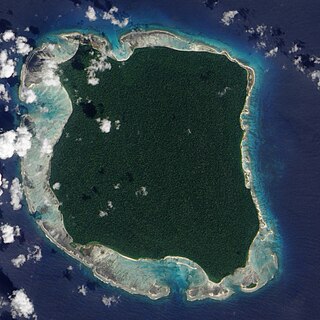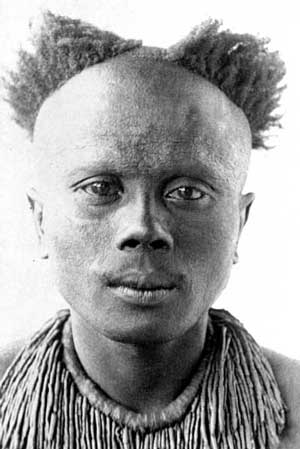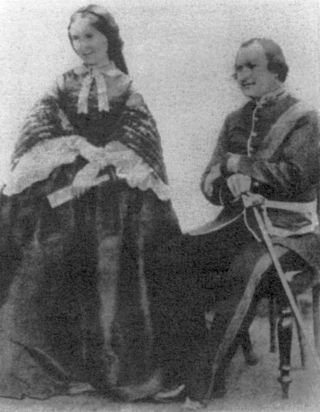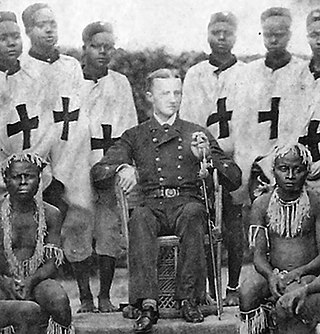
The Andaman Islands are an archipelago, made up of 200 islands, in the northeastern Indian Ocean about 130 km (81 mi) southwest off the coasts of Myanmar's Ayeyarwady Region. Together with the Nicobar Islands to their south, the Andamans serve as a maritime boundary between the Bay of Bengal to the west and the Andaman Sea to the east. Most of the islands are part of the Andaman and Nicobar Islands, a Union Territory of India, while the Coco Islands and Preparis Island are part of the Yangon Region of Myanmar.

Penal transportation was the relocation of convicted criminals, or other persons regarded as undesirable, to a distant place, often a colony, for a specified term; later, specifically established penal colonies became their destination. While the prisoners may have been released once the sentences were served, they generally did not have the resources to return home.
The Andamanese languages are the languages spoken by the indigenous Andamanese peoples of the Andaman Islands in the Indian Ocean. It contains two known language families, Great Andamanese and Ongan, as well as two presumed but unattested languages, Sentinelese and Jangil.

North Sentinel Island is one of the Andaman Islands, an Indian archipelago in the Bay of Bengal which also includes South Sentinel Island. It is home to the Sentinelese, an indigenous tribe in voluntary isolation who have defended, often by force, their protected isolation from the outside world. The island is about 8 kilometres (5.0 mi) long and 7 kilometres (4.3 mi) wide, and its area is approximately 60 square kilometres (23 sq mi).

The Sentinelese, also known as the Sentineli and the North Sentinel Islanders, are an indigenous people who inhabit North Sentinel Island in the Bay of Bengal in the northeastern Indian Ocean. Designated a particularly vulnerable tribal group and a Scheduled Tribe, they belong to the broader class of Andamanese peoples.

The Andamanese are the various indigenous peoples of the Andaman Islands, part of India's Andaman and Nicobar Islands, the union territory in the southeastern part of the Bay of Bengal. The Andamanese are a designated Scheduled Tribe in India's constitution.

Port Blair is the capital city of the Andaman and Nicobar Islands, a union territory of India in the Bay of Bengal. It is also the local administrative sub-division (tehsil) of the islands, the headquarters for the district of South Andaman, and the territory's only notified town.

The music of the Andaman and Nicobar Islands are a mixture of the indigenous cultures of the islands, as well as more recent cultural influencers from the descendants of the early settlers in the island from the Indian subcontinent. Folk traditions of the area include that of the Moken seafarers and various kinds of ritual tribal dance.

The Great Andamanese are an indigenous people of the Great Andaman archipelago in the Andaman Islands. Historically, the Great Andamanese lived throughout the archipelago, and were divided into ten major tribes. Their distinct but closely related languages comprised the Great Andamanese languages, one of the two identified Andamanese language families.

The Onge are an Andamanese ethnic group, indigenous to the Andaman Islands in Southeast Asia at the Bay of Bengal, currently administered by India. They are traditionally hunter-gatherers and fishers, but also practice plant cultivation. They are designated as a Scheduled Tribe of India.
The Jarawas are an indigenous people of the Andaman Islands in India. They live in parts of South Andaman and Middle Andaman Islands, and their present numbers are estimated at between 250–400 individuals. They have largely shunned interaction with outsiders, and many particulars of their society, culture and traditions are poorly understood. Since the 1990s, contacts between Jarawa groups and outsiders grew increasingly frequent. By the 2000s, some Jarawas had become regular visitors at settlements, where they trade, interact with tourists, get medical aid, and even send their children to school.

Robert Christopher Tytler was a British soldier, naturalist and photographer. His second wife Harriet C. Tytler is well known for her work in photographing and documenting the monuments of Delhi and for her notes at the time of the 1857 revolt in India. Mt. Harriet in the Andamans is named after her. A species of bird, Tytler's leaf warbler, is named after him.

The Great Andamanese languages are a nearly extinct language family once spoken by the Great Andamanese peoples of the northern and central Andaman Islands in the Indian Ocean, and part of the Andamanese sprachbund.

Ross Island, officially known as Netaji Subhash Chandra Bose Island, is an island of the Andaman Islands. It belongs to the South Andaman administrative district, Andaman and Nicobar Islands. The island is situated 3 km (2 mi) east from central Port Blair. The historic ruins are a tourist attraction.

Maurice Vidal Portman was a British naval officer, who is best known for documenting and kidnapping some of the Andamanese tribes between 1879 and 1901 when he was posted as a superintendent of the Andaman Island Penal Colony.

Ross Island Penal Colony was a convict settlement that was established in 1858 in the remote Andaman Islands by the British colonial government in India, primarily to jail a large number of prisoners from the Indian Rebellion of 1857, also known as the Indian Mutiny. With the establishment of the penal colony at Ross Island, the British administration made it the administrative headquarters for the entire group of Andaman and Nicobar Islands and built bungalows and other facilities on the site. This colony was meant as "manageable models of colonial governance and rehabilitation". The Chief Commissioner's residence was located at the highest point on the island. Over time, several other islands including Chatham and Viper were used for the penal colony.

John Andaman or Jack Andaman was the name given to an Andaman native who was taken captive aboard a British navy ship near Interview Island on a survey of the Andaman Islands under Frederic J. Mouat. He was taken to Calcutta and returned to the place of his capture when ill health began to torment him. It has been suggested that Sir Arthur Conan Doyle described Tonga, an Andamanese native character, in his 1890 novel The Sign of Four based on Mouat's description of John Andaman.
Dudhnath Tiwari was an Indian convict from the Sepoy mutiny who was sent to the penal settlement in the Andamans and became famous for escaping and living with the Andamanese tribes for about a year. Accounts of life among the tribals, though coloured by his own prejudices and by possible embellishments, became famous in his time. During the time that he spent among the tribes, he came to learn of a tribal uprising being planned against the British at the penal settlement at which point he chose to return to the penal settlement and reveal the plans. The British penal settlement officers then prepared themselves for what was known as the Battle of Aberdeen in which the tribals were defeated. For his actions Tiwari was pardoned.
Madhumala Chattopadhyay is an Indian anthropologist who specializes in the Indigenous peoples of the Andaman and Nicobar Islands. In 1991, Chattopadhyay and her colleagues were the first outsiders to make peaceful contact with the Sentinelese people.
The Andaman and Nicobar Islands is an archipelago of 572 islands of which 37 are inhabited. It is a union territory of India.















